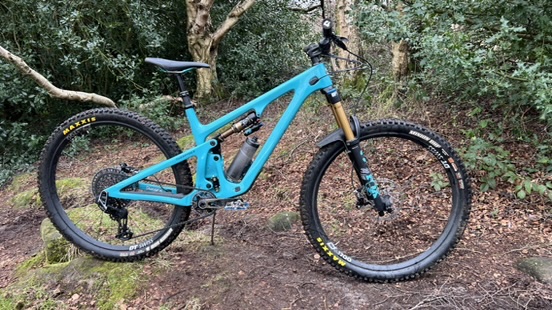
Yeti offers three mountain bikes in its full suspension 29er range, with the SB140 sitting centrally between the SB120 lightweight trail bike and the SB160 Enduro racer. However, the iconic Colorado company says this is “THE BIKE IN BETWEEN NOTHING. MASTER OF THE CLIMB, THE BOMB, THE RAIL, AND THE AIR. THE UTTERLY UNEQUIVOCAL. THE RULE CRUSHER. THE TREND BUSTER.” The Lunch Ride version adds a 160mm fork to the 140mm chassis to give even more punching power to the bike the iconic Colorado company says “CAN ABSOLUTELY RULE”. But how does the block capital trash-talking hype hold up after months of flat-out trail riding?
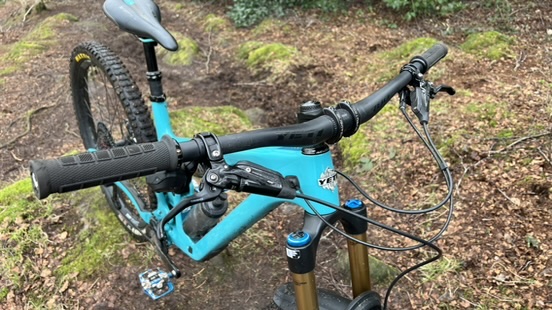
Design
The SB140 follows on the heels of the SB130, but the frame has been reprofiled. Most noticeably the rubber armored ‘belly’ ahead of the bottom bracket has been lifted to add clearance. The swingarm tubes are also slightly shallower, although overall ‘holistic stiffness’ is increased according to Yeti. You get a UDH gear hanger, as well as thick belly armor and top, bottom, and underside chain slap protection.
Yeti hasn’t added internal storage to the frame though so it still has a relatively slim feel compared to ‘cargo’ bikes from other brands. The asymmetric swingarm also curves its way inwards to join the Switch Infinity main pivot and the whole frame vibe is organic and flowing rather than stoutly.
In terms of features though the SB140 feels like a previous generation bike. The top tube mounted shock means space is limited to a single bottle and maybe a strapped inner tube within the frame on most sizes. While most riders on large, extra large, and extra extra large frames can use a 200mm plus dropper post, medium frames use a 175mm stroke post, and smalls are likely limited to 150mm by the space taken up by the Switch Infinity system. There’s not a single geometry tweak to be had anywhere, nor mention of mullet compatibility either. Most home mechanics will be grateful Yeti has stuck with clamped control cabling running into the frame rather than through the headset. There's 2.6in tire clearance at the rear, a really smart two-piece ‘puzzle’ linkage to drive the rear shock. All bearings are pressed into the linkages rather than the carbon mainframe or swingarm too, removing worries about wear on non-replaceable parts. All frame sizes get a different carbon layup to keep the ride vibe the same and there’s a lifetime warranty as well. If you can’t stump up the dollars for the top-spec Turq bikes, then the standard carbon frame has all the same features and geometry but uses a heavier fiber blend and the old Switch Infinity knuckle design.
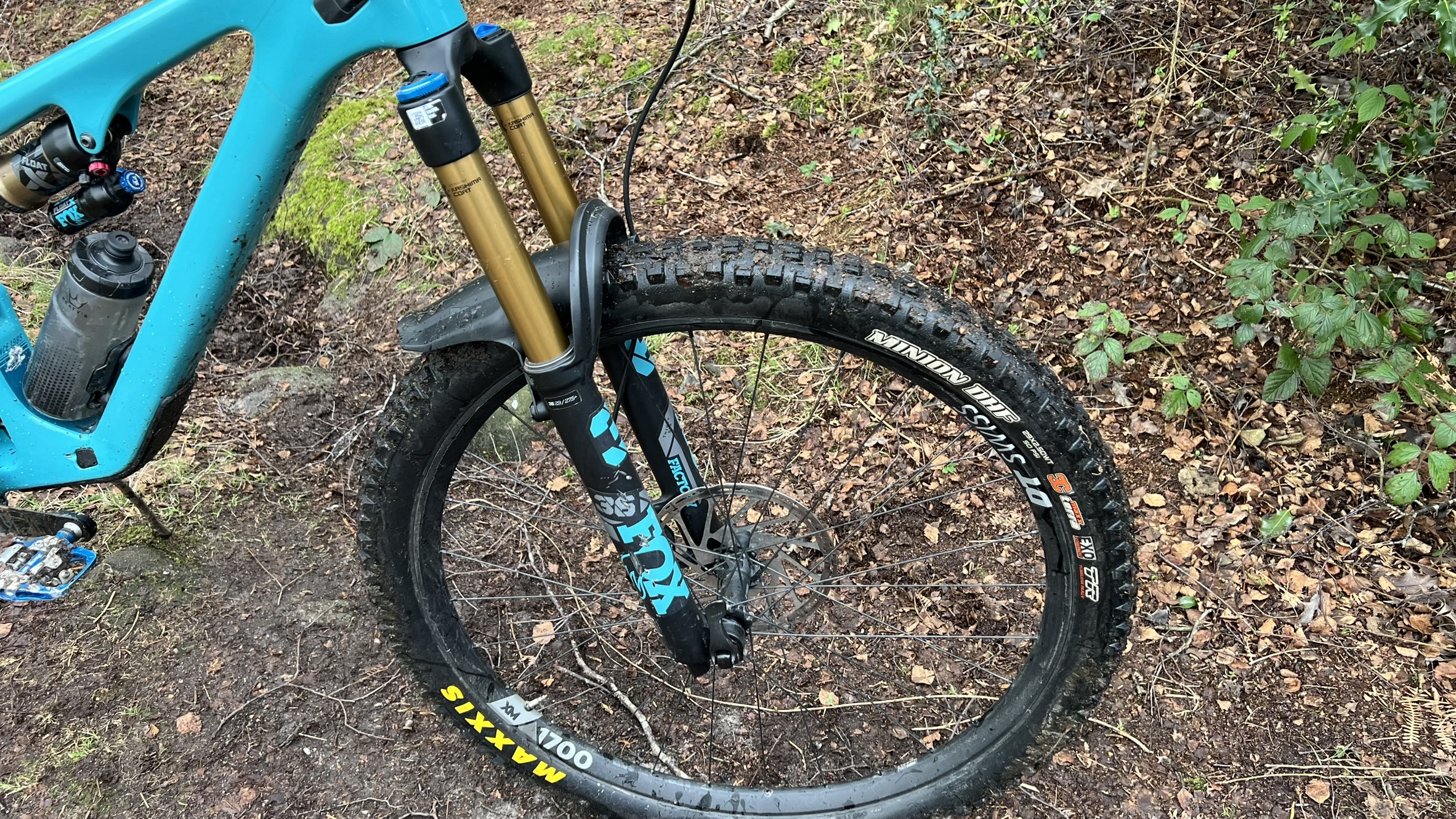
Geometry
In the same way the frame is slightly slimmer than most bikes in its category, the head angle isn’t as gravity-aggressive either. Even with the longer fork slackening it by half a degree it still sits at 65 degrees. The short (100mm on the large I tested) head tube keeps the stack relatively low at 625mm. Otherwise, the numbers are similar to most bikes in this bracket. The 480mm reach gives plenty of real estate to settle into a centralised position though and chain stay lengths increase by 2mm every size from 436mm on the small to 444mm on the XXL. The effective seat angle sits around 67 degrees depending on how high you have your saddle in the 72.5-degree tube. Bottom bracket height is 342mm unsagged.
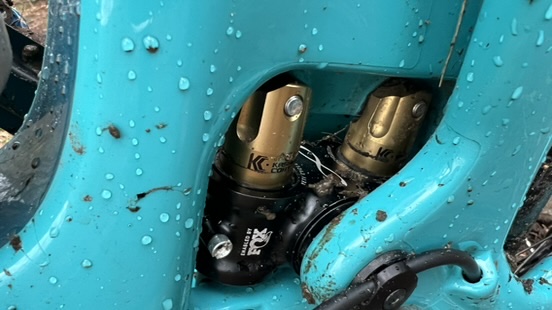
To Infinity and beyond
If you’re wondering what all this Switch Infinity talk is, Yeti’s unique suspension design is based around a ‘translating’ (Yeti’s words not ours) main pivot. The ‘translation’ aspect comes from the fact the pivot is mounted in a knuckle that’s free to slide up and down two short, Fox Kashima-coated gold shafts bolted into the center of the frame. As the suspension compresses, the pivot moves upwards fractionally, keeping anti-squat and pedal feedback high for positive pedaling. Then as it reaches the ‘inflection point’ the pivot starts to drop down again, reducing the anti-squat and rearward wheel movement for increased impact capacity. The leverage ratio also starts at 2.7 dropping to around 2.3 at full compression. The overall progression rate is 14 percent which again sits between the SB120 and the SB160.
Given that previous generations of Switch Infinity have tended to be maintenance-heavy, with serious self-harming tendencies if left unloved, the good news is that all Turq-level bikes now get an updated knuckle design. The main pivot axle is a user-serviceable collet design with a grease injection port. Bushings and seals have all been uprated for smoother, cleaner running too and so far everything is still fine even after a particularly filthy winter of riding.
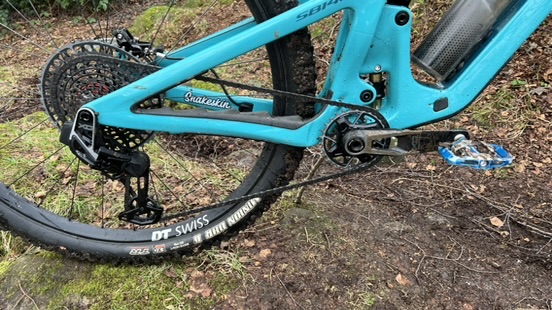
Components and build
In terms of brands, the SB140 T3 is a who’s who of proven components, but considering the price there are slight disappointments in most areas. The SRAM XO T-Type AXS Transmission offers super solid up-to-date shifting, but the SRAM Code RSC brakes are the previous generation rather than the latest ‘Stealth lever’ style.
The Fox 36 fork and Float X piggyback shock are top dollar, gold shafted Factory spec, but the Transfer dropper post is black shafted, third-tier Performance spec. The DT Swiss XM1700 wheels are sweet-riding, solidly reliable stalwarts but they’re heavy at nearly 2kg and the XM1501 carbon upgrade option ($1,000 in the US) isn’t offered in the UK. You get Yeti’s own carbon bar with Yeti ODI grips clamped into the Burgtec stem and the WTB saddle is a custom Yeti ‘desert turquoise’ design. The use of trail spec Exo carcass, MaxTerra compound Maxxis tires rather than anything tougher or grippier tells the same story as the relatively slim frame elements and moderate head angle.
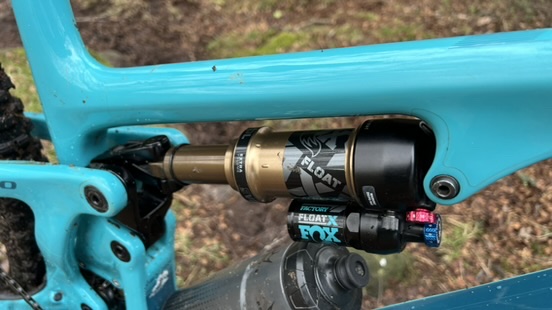
Ride, handling and performance
That story is entirely true to the feel of the SB140 on the trail too. Because while the SB140 web page might be all big claims in block capitals, the way it writes its ride on the trail is an increasingly rare tale and one of subtlety and sophistication. Backing off on the head angle slightly means you’re not just a tram passenger locked into a straight line Strava attack on the fastest line. There’s a little bit left for you to do in terms of guidance and guile on descents, but a more responsive less disinterested front wheel feel on the climbs. That’s backed up by the way the Switch Infinity stays higher and tighter the more power you put through the pedals. So while it’s relaxed and composed if you’re cruising around sag, tense your muscles to attack out of a turn or up a climb and the SB140 will respond in kind. The seat angle, that feels slacker than the numbers would suggest when easing along between exciting bits, also perks up and pushes you into a more aggressive position as your elbows drop and your heart rate climbs. As a result, while the spec and the complicated frame might leave it relatively heavy, this is undoubtedly one of the outstanding climbing bikes in its category.
That’s before the real magic happens as that main pivot creeps up and then flips downwards at the inflection point. It’s no accident that this happens just when you need it to either, giving an AI electric sensor feel from a purely mechanical system. When you’re hustling hard on the pedals, the Switch happens when you hit something that would blow your feet backward or spit traction on a bike that maintained the same anti-squat levels throughout the stroke. On a descent it opens up easier, smoother stroke just when a fixed position bike might choke or stall on a block or drop, helping you sustain speed and hold a balanced position rather than stalling or being thrown forward. As you might expect from a system that literally revolves around just a few mm of travel though, it’s all very subtle and nuanced, not comically caricatured like the trapdoor effect of a high pivot bike. With no extra cogs in the machine it feels clean and effortless through the pedals too, and the longer the ride, the more you’ll appreciate that quiet efficiency.
Yeti has done a great job of curating the frame feel to match as well. The low, organically shaped front end also has an element of compliance that helps it cling on where other bikes might lift or shimmy. The nipped-in waist where the swingarm meets the mainframe allows a little bit of twist to let the back end key into the grain of the trail rather than skipping across it. Again, very much a background gain that’s not immediately obvious at first, but a crucial control ally you increasingly come to rely on as you get more tired or the trail gets more rowdy. The unsurprising flipside of this is that occasionally the Fox 36 feels more like a 34 in terms of how hard you can hold onto a line. As efficient as it feels overall, it doesn’t boot you forward like a Subaru with a bean tin exhaust and a flatulent turbo, but it doesn’t make you feel like an anesthetized passenger on a pillowy hovercraft either. I can immediately think of several bikes (I've mentioned a few below) that’ll give you those sensations, but none that’ll deliver the quietly incredible in the way the SB140 does, and none with a similar roll call of MTB icons who’ve raced with a drifting Yeti head badge either.
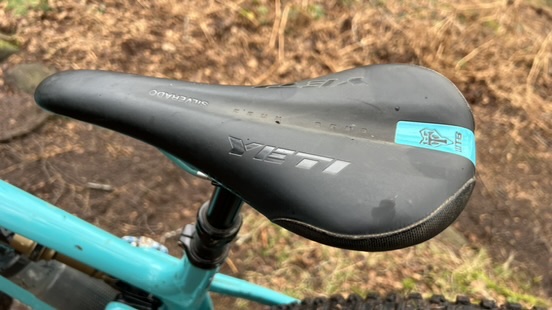
Verdict
If you’re looking for top value in this category check out the Canyon Spectral CF7. If you want a seriously hench, hero-time all-rounder with internal storage and similar trailhead kudos then the Santa Cruz Hightower is probably your go-to. Need smoothly neutral suspension, huge amounts of geometry adjustment potential, and more parcel space than a UPS van? Then check out the Specialized Epic 8 Evo Pro. Minimal maintenance and easy cleaning with a similar old-school MTB history? There has to be something in the myriad of single-pivot bikes Orange offers to suit you.
Pick the Yeti if don't look at the prices on menus but you really appreciate refined quality. If you want a subtle, sophisticated bike that’s a gradual, glorious grower, not an in-your-face show-er. This SB140's unique mix of engineered AI-like suspension, beautifully balanced geometry, and frame feel transcends a straight value-for-money comparison. And it does it by creating a subtle, but unmistakable feel that every part of the bike – including you – is just working better than it normally does. This is lucky, because in terms of Top Trumps spec check, the price stinks, and Yeti are about the only brand who’s not done a Covid clearout sale. But then again, that alone should tell you something about the difference between value and price.
Test conditions
- Surface: Recreation and Enduro race riding natural loam, roots, and loose rock, plus built black run boulder and berm time.
- Trails: Natural Enduro courses, moorland singletrack, red and black grade trail center runs, and off-piste play trails
- Weather: All of it. From miserable everlasting winter to a few fleeting hard packed dusty days that we’ll probably have to call summer 2024.
Tech specs: Yeti SB140 LR T3 X0 Turq
- Discipline: Trail
- Price: $9,000 / £8,999
- Head angle: 65 degrees
- Frame material: Turq Series carbon fibre
- Size: S, M, M/L, L (tested), XL
- Weight: 14.58kg
- Wheel size: 29in
- Fork: FOX FACTORY 36 GRIP 2/160mm travel
- Chainset: SRAM XO 170mm arms with 30T chainring and DUB bottom bracket.
- Rear mech: SRAM Eagle AXS XO, T-Type
- Shifter: SRAM Eagle AXS Pod Controller
- Cassette: SRAM Eagle XO CS-1275 12-speed 10-52T
- Brakes: SRAM Code RSC 4 piston hydraulic disc brakes with 200/180mm rotors
- Tires: Maxxis Minion DHF EXO 29x2.5in front and Maxxis Minion DHR II EXO 29x2.4in rear
- Wheels: DT Swiss XM1700
- Bars: Yeti Carbon 800 x 35mm
- Stem: Burgtec Enduro Mk3 35mm
- Grips: ODI Elite Pro
- Seat post: Fox Transfer 200mm stroke, 31.6mm diameter
- Saddle: WTB Silverado Yeti custom







